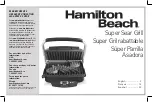
English
1
EN
FR
DE
ES
IT
NL
PT
DA
SV
FI
NO
RU
PL
CS
HU
RO
LV
LT
ET
HR
SL
SK
BG
UK
TR
EL
Safety, performance, and dependability have been given
top priority in the design of your percussion drill.
INTENDED USE
The percussion drill / driver is intended to be used only by
adults who have read and understood the instructions and
warnings in this manual and can be considered responsible
for their actions.
The percussion drill/driver can be used for drilling into
various materials, including wood, metal, and plastics
using a drill bit with shank having a diameter of less than
PP:KHQ¿WWHGZLWKDVXLWDEOHVFUHZGULYHUELWLWFDQ
be used for inserting and removing screws. It can also be
used in impact drilling mode for drilling masonry and similar
materials.
Do not use the percussion drill/driver in any way other than
those stated for intended use.
WARNING
Read all safety warnings, instructions, illustrations
and specifications provided with this power tool.
Failure to follow all instructions listed below may result in
HOHFWULFVKRFN¿UHDQGRUVHULRXVLQMXU\
Save all warnings and instructions for future reference.
DRILL AND SCREWDRIVER SAFETY WARNINGS
SAFETY INSTRUCTIONS FOR ALL OPERATIONS
Ŷ
Wear ear protectors when impact drilling.
Exposure
to noise can cause hearing loss.
Ŷ
Use the auxiliary handle(s).
Loss of control can cause
SHUVRQDOLQMXU\
Ŷ
Brace the tool properly before use.
This tool
produces a high output torque and without properly
bracing the tool during operation, loss of control may
RFFXUUHVXOWLQJLQSHUVRQDOLQMXU\
Ŷ
Hold the power tool by insulated gripping surfaces,
when performing an operation where the cutting
accessory or fasteners may contact hidden wiring
or its own cord.
Cutting accessory or fasteners
contacting a “live” wire may make exposed metal parts
of the power tool “live” and could give the operator an
electric shock.
SAFETY INSTRUCTIONS WHEN USING LONG DRILL
BITS
Ŷ
Never operate at higher speed than the maximum
speed rating of the drill bit.
At higher speeds, the
bit is likely to bend if allowed to rotate freely without
FRQWDFWLQJWKHZRUNSLHFHUHVXOWLQJLQSHUVRQDOLQMXU\
Ŷ
Always start drilling at low speed and with the bit
tip in contact with the workpiece.
At higher speeds,
the bit is likely to bend if allowed to rotate freely without
FRQWDFWLQJWKHZRUNSLHFHUHVXOWLQJLQSHUVRQDOLQMXU\
Ŷ
Apply pressure only in direct line with the bit and do
not apply excessive pressure.
Bits can bend causing
EUHDNDJHRUORVVRIFRQWUROUHVXOWLQJLQSHUVRQDOLQMXU\
ADDITIONAL SAFETY WARNINGS
Ŷ
Clamp workpiece with a clamping device.
8QFODPSHG ZRUNSLHFHV FDQ FDXVH VHYHUH LQMXU\ DQG
damage.
Ŷ
Wear safety goggles to protect your eyes from flying
particles and splinters.
Ŷ
:KHQZRUNLQJRQZDOOVFHLOLQJVRUÀRRUVDYRLGKLWWLQJ
electrical wiring and gas or water pipes.
Ŷ
The product will restart automatically if stalled. Switch
off the product immediately if it stalls. Do not switch on
the product again while it is still stalled, as doing so
could trigger a sudden recoil with a high reactive force.
Determine why the product stalled and rectify this,
paying heed to the safety instructions.
RESIDUAL RISKS
Even when the product is used as prescribed, it is still
impossible to completely eliminate certain residual risk
factors. The following hazards may arise and the operator
should pay special attention to avoid the following:
Ŷ
Risk of electrocution if electric cables are drilled into
–
Always grasp the tool by designated handles, do
not touch the drill bits.
Ŷ
Damage to the respiratory system
–
Wear respiratory protection masks containing filters
appropriate to the materials being worked. Ensure
adequate workplace ventilation. Do not eat, drink or
smoke in the work area.
Ŷ
Damage to hearing
–
Always wear effective hearing protection and limit
exposure to noise.
Ŷ
Damage to eyes from flying dust and debris particles
–
Always wear suitable eye protection.
Ŷ
,QMXU\FDXVHGE\YLEUDWLRQ
–
Hold the tool by designated handles and limit
exposure to vibration. See “RISK REDUCTION”.
RISK REDUCTION
It has been reported that vibrations from handheld tools
may contribute to a condition called Raynaud’s Syndrome
in certain individuals. Symptoms may include tingling,
QXPEQHVV DQG EODQFKLQJ RI WKH ¿QJHUV XVXDOO\ DSSDUHQW
upon exposure to cold. Hereditary factors, exposure to
cold and dampness, diet, smoking, and work practices
are all thought to contribute to the development of these
symptoms. There are measures that can be taken by the
operator to possibly reduce the effects of vibration:
Ŷ
Keep your body warm in cold weather. When operating
the product, wear gloves to keep the hands and wrists
warm.
,WLVUHSRUWHGWKDWFROGZHDWKHULVDPDMRUIDFWRU
contributing to Raynaud’s Syndrome.
Summary of Contents for RPD500
Page 36: ...34...
Page 38: ...36 V Hz W no PLQ 58...
Page 70: ...68 PP...
Page 72: ...70 3 V Hz W no PLQ XU VLDQ...
Page 73: ...71 EN FR DE ES IT NL PT DA SV FI NO RU PL CS HU RO LV LT ET HR SL SK BG UK TR EL...
Page 74: ...72 1 2 3 4 5 6 7...
Page 75: ...73 EN FR DE ES IT NL PT DA SV FI NO RU PL CS HU RO LV LT ET HR SL SK BG UK TR EL V Hz W no PLQ...
Page 79: ...77 EN FR DE ES IT NL PT DA SV FI NO RU PL CS HU RO LV LT ET HR SL SK BG UK TR EL PP R R...
Page 80: ...78 5D QDXG 5D QDXG 1 2 3 4 5 6 7...
Page 82: ...80 x 1 x 1...
Page 83: ...81 1 2 3 6 4 5 7...
Page 84: ...82 1 3 2 1 2 5 6 1 2...
Page 85: ...83 4 3 7 1 2...
Page 86: ...84 2 1 1 2 1 2 3 2 1 20190826v11...
Page 87: ......
Page 116: ...20190826v11 Techtronic Industries GmbH Max Eyth Stra e 10 71364 Winnenden Germany...




































